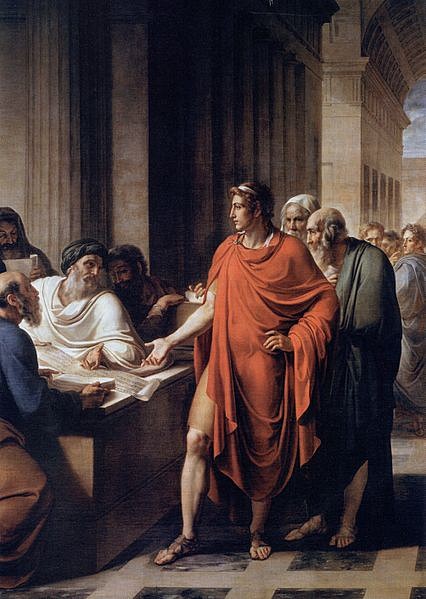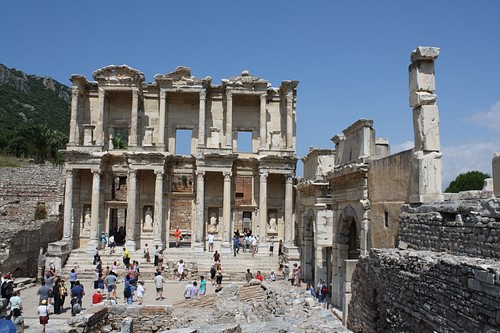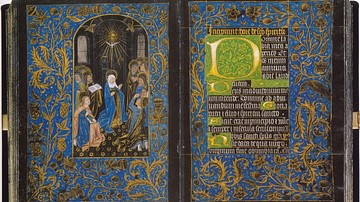Libraries were a feature of larger cities across the ancient world with famous examples being those at Alexandria, Athens, Constantinople, Ephesus, and Nineveh. Rarely ever lending libraries, they were typically designed for visiting scholars to study and copy whatever they were most interested in. Not until the Roman period did genuinely public libraries allow all comers to come and read as they wished. Texts in ancient libraries were typically kept on papyrus or leather scrolls, inscribed on wax and clay tablets or bound in parchment codexes, and they covered everything from how to read omens to the letters sent between ancient rulers. Books were acquired through purchase, copying, and donations but were also one of the items taken away from cities by their conquerors; such was the value put on knowledge in antiquity.
The Concept of a Library in Antiquity
Libraries in antiquity were not always designed for the public to freely consult texts or take them off-site as libraries function today, although some did offer this service. Many libraries in the Near East and Egypt were attached to sacred temple sites or were part of an administrative or royal archive, while in the Greek and Roman worlds these types continued but private collections became much more common, too. When libraries were open to the public, then they were usually aimed at permitting visiting scholars to consult and copy texts rather like a modern reference library or the archive of a research institute functions today. Libraries began to offer more than just books in the Roman period, with lectures put on, orators invited to impress, and intellectuals gathering to discuss matters with fellow visitors in the tranquillity of the library audience hall or garden.
Ancient texts could come in many forms such as scrolls made of papyrus (the dominant form) or leather, or be inscribed on wax or clay tablets. Papyrus scrolls were long, 6-8 m (20-26 ft.) being the standard and sometimes both sides were used to write on, typically in columns and with a wide margin left blank for later notes. The papyrus was wrapped around a wooden stick and could be treated to preserve the material, for example, cedar oil was added to ward off worms. Leather scrolls were made by tanning the material or, in the case of vellum or parchment, soaked in slake lime and then scraped and smoothed using pumice. In the Roman period (1st to 4th century CE), sheets of parchment could also be tied together using leather thongs or stitching to form a codex book, sometimes with a leather or wooden cover. The codex was much more user-friendly as it allowed for more text, one could more easily find specific passages (hence the bookmark was born) and it took up less shelf-space than a scroll. The subject matter of ancient texts involved all aspects of ancient societies and included religion, sciences, mathematics, philosophy, medicine, and the correspondence of rulers.
Near Eastern Libraries
Libraries were a fixture of Near Eastern cities from the second half of the second millennium BCE. The Assyrians, Babylonians, and Hittites all had them, as did Syrian cities like Emar and Ugarit. The texts in them took different forms and could be written on leather scrolls (magallatu), wooden writing boards covered in wax, papyrus, and clay tablets. The latter are the only ones to survive (in prodigious numbers), but they themselves make mention of the other media used to keep written records and texts safe for future generations of readers. Often a text runs across several tablets, sometimes as many as 100. Languages used included cuneiform, Akkadian, Sumerian, Hurrian, and Greek.
The cultures of the Near East had three types of libraries, a diversification which was seen in many later states elsewhere. These were the library within a royal palace, at temple sites, and in private homes. The most common was the second category as this was where most scholars and those able to read and write were found.
The Assyrian palace library at the capital Nineveh, often called the Library of Ashurbanipal after the King of Assyria of that name (r. 668-627 BCE) but actually put together by several different rulers, was begun in the 7th century BCE if not earlier. This library was largely composed of texts in cuneiform and covered just about everything the kings could get their hands on from hymns to myths. The texts were acquired by copying or simply taking those found in other libraries, via donations from private individuals, and as a result of conquest. Scholars estimate that just the tablet section consisted of 30,000 clay tablets, and those that were part of Ashurbanipal's private collection are especially finely written and sealed. While everyone mourns the loss of the Library of Alexandria (see below), Nineveh's library suffered a similar tragedy when it was destroyed during the invasion of the Medes in 612 BCE. Fortunately, many of the works had already been copied and survived in other Assyrian libraries.
Famous temple libraries existed at Babylon, Kalhu, Sippar, and Uruk. Here, scholars - in residence or just visiting - would make copies of texts, many of which might end up in a private library. The latter were not quite so private as the name suggests but were, rather, bodies of texts on specific subjects to be used by certain teachers or other professions and might be linked to a temple site. The works covered subjects like ritual and religion (especially incantations, prayers for exorcism, and any other ritual that required a precise formula to be spoken), scholarly findings in mathematics and astronomy, medicine and how to read omens correctly.
Egyptian Libraries
Collections of textual resources similar to modern archives were kept in ancient Egypt from the Old Kingdom onwards, and these included documents regarding cults, sacred texts, magical texts, and administrative records. Egyptian libraries were more than repositories of old texts, though, and were regularly added to with contemporary texts, especially regarding government and even the letters of pharaohs. The Egyptians also had many different types of library, which were distinguishable from pure archives and which could carry such names as 'house of books' (per-medjat), 'house of writings' (per-seshw), and 'house of the divine words' (per-medw-netjer). The precise meaning of these terms is not known and no doubt varied over time. As in the Near East, Egyptian libraries were frequently associated with temple sites and royal palaces. A small excavated library at Edfu reveals that papyrus scrolls were kept there in chests in niches in the walls.
The Egyptians possessed perhaps the most famous library of all time at Alexandria, although despite its celebrity we still do not know exactly when it was founded or when it was destroyed. Most ancient sources credit Ptolemy II Philadelphos (r. 285-246 BCE) with its foundation. A combination of a royal and public library, it was one of the earliest to permit someone not actually charged with looking after the library to enter and study therein the 500,000-700,000 scrolls. It is doubtful, though, that just anyone could enter the library as it was most likely reserved for the use of a small community of scholars.
The Ptolemaic Dynasty spent a great deal of time and money building up the library of Alexandria, acquiring texts from all over the Mediterranean. Books were bought at markets in such cities as Athens and Rhodes, any official correspondence was added, copyists and commentators created whole new books, and even ships arriving at Alexandria might have any texts they carried confiscated and added to the city's collection. The librarians, operating under a director, were ruthless and absolutely determined to build the world's greatest store of knowledge by leaving no source and no subject uncovered.
To make finding a scroll again a little easier, the library's vast contents were divided into genre sections such as tragic poetry, comedy, history, medicine, rhetoric, and law. The librarians did not merely accumulate texts as they also catalogued them, organised them into books, chapters and numbering systems (many of which are still used today), and they added such notes as when a play had been performed and where. Sometimes a brief critical evaluation was added to a text and guides were written about groups of texts, lists were drawn up of which authors should be consulted on a given topic, and mini-encyclopedias created which gave brief biographies of authors and their major works. There were even scholars who specialised in checking the authenticity of antiquarian texts.

The library, no longer fully supported by the state, fell into decline from the mid-2nd century BCE. Julius Caesar (l. 100-44 BCE) was blamed by such ancient writers as Plutarch (l. c. 45 - c. 125 CE) for burning down the library, although it survived in some form, only to suffer more fires c. 270 CE and in 642 CE. Whatever the exact history of the library's demise, fortunately for posterity, many of the Alexandrian texts were copied over the centuries and these often ended up in Byzantine libraries which were then printed during the Renaissance creating a tangible link between the ancient papyrus scrolls and those editions found today in university libraries and elsewhere.
Greek Libraries
Greek libraries continued to be dominated by papyrus scrolls although an indicator that books were now becoming a more common sight outside of institutions is that for the Greeks, the term library could refer both to the place where texts were stored and any small collection of books, now easily available in the 5th-century BCE markets of Athens. One of the owners of a celebrated collection was the tyrant Polycrates of Samos (r. 538-522 BCE). The first Greek public library is credited by ancient authors to the efforts of Peisistratos of Athens (d. c. 527 BCE). The thoughts of the famous Greek philosophers were one of the great sources of books - Aristotle was a noted collector himself - but there did continue to be a debate on which was superior for teaching: the spoken or written word.
Hellenistic leaders often saw libraries as a way to promote their rule and present themselves as learned and enlightened rulers. They might thus publicly sponsor or endorse certain writers who gained scholarly (and political) acceptance by having their works admitted to an official library. We have already seen the Ptolemies' efforts in Alexandria, but others of the period included Pella, Antioch, and at Pergamon, created by the Attalids (282-133 BCE), said to have had 200,000 scrolls. Another developing trend was for the gymnasium present in many Greek cities to receive a library as that place became just as associated with learning as physical exercise.
Roman Libraries
The first reference to a library in Rome is the collection of books the general and consul Aemilius Paullus (c. 229 - 160 BCE) brought home after he defeated Perseus of Macedon (c. 212 - 166 BCE) in 168 BCE. This was a model oft-repeated, perhaps most infamously by Sulla's appropriation of Aristotle's library when he sacked Athens in 84 BCE. As in earlier cultures, libraries were particularly associated with temples, palaces, and state archives, and, as in Greece, the gymnasium-library combination, now called the palaestra, was continued. Roman writers were prolific commentators on the works of their Greek predecessors and so clearly they had access to those texts in libraries. Roman libraries tended to be divided inside into two areas: one for Latin and another for Greek works.
The increasing number of children sent to educators was a boom to book-creation, and there developed the idea that a respectable Roman citizen should not only possess a good knowledge of literature but also have his own collection of books, a private library which was often made available to a wide circle of family and friends. One such library has been excavated at Herculaneum. Belonging to L. Calpurnius Piso (Julius Ceasar's father-in-law), there are the charred remains of some 1,800 scrolls which would have been kept in wall niches or partitioned cupboards (armaria) arranged around a central reading table.
By the end of the Roman Republic, figures such as Julius Caesar, the consul Asinius Pollio (75 BCE - 4 CE) and then emperor Augustus (r. 27 BCE - 14 CE), began to act on the idea that books belonged to everyone and so they built the first genuinely public libraries as opposed to the scholars-by-invite institutions of previous eras. That famous libraries were actually available to all and designed to be so is referenced by such writers as Ovid (43 BCE - 17 CE) and Pliny the Elder (23-79 CE). One sign that survives from the library of Pantaenus in Athens states: 'No book shall be taken out…Open from dawn to midday' (Hornblower, 830). Typically, an attendant would fetch the desired scroll while copyists and restorers might be at work behind the scenes.
There were so many libraries - the city of Rome would end up with perhaps 28 public libraries alone - that Vitruvius (c. 90 - c. 23 BCE), the famed architect and scholar, devoted a section of his On Architecture to the proper considerations when building a library. He recommended that a library face east for both the best light and to reduce damp. Other writers advised that library floors should be of green marble and ceilings should certainly not be gilded so as to avoid any glare and unnecessary strain on the eyes.
Roman libraries came to be the place where an author first released their work to the public, reading out loud to a small audience. Augustus' Palatine library was additionally used for all kinds of meetings, including imperial audiences and sessions of the Roman Senate. Another possible combination of function was to have libraries in Roman baths; the baths of Trajan (r. 98-117 CE), Caracalla (r. 211-217 CE), and Diocletian (r. 284-305 CE) in Rome all have rooms identified by at least some scholars as libraries, although presumably, if they were, one was not permitted to take a scroll into the steam room. As with other elements of their culture, the Romans spread the idea of public libraries across their empire with famous ones being established at Ephesos (the Library of Celsus, completed in 117 CE) and Athens (the Library of Hadrian, completed c. 134 CE). Other famous libraries of the 2nd century CE included those at Rhodes, Kos, and Taormina (Tauromenium).
Byzantine Libraries
Although the Byzantine Empire possessed an imperial library and a patriarchal one (headed by the chief bishop) for much of its history and boasted one of the great libraries at Constantinople with its 120,000 scrolls (it burnt down c. 475 CE) generally, in Late Antiquity, public libraries began to disappear in the Roman-Greek world. Books certainly did not disappear altogether though, and Byzantine monasteries became the great preservers of ancient texts in their libraries. Acquired through diligent copying and the donations of kind patrons, a typical monastery was doing well if it could boast 50 books, and these were really only for scholars to consult as libraries returned to the more limited role they had played in the Near East and Egypt.
New books were produced, largely thanks to the Christian religion which, unlike with the older pagan beliefs, transferred ideas to new followers using the written word rather than just oral instruction. The converted were also reminded of stories, hymns, and rituals thanks to texts. The endless debates that Christian scholars created with new ideas and interpretations of older texts, their commentaries and the resulting schisms all caused a boom in both book production and reading (but also sometimes the destruction of those books considered subversive). Notable examples of Byzantine libraries are those in the monasteries on Mount Athos and Mount Sinai which contain around one-quarter of all surviving medieval manuscripts. It is largely thanks to Byzantine monks, then, forever busy producing their beautiful but expensive illuminated manuscripts, that today we can read, study, and enjoy the works of such names as Herodotus, Sophocles, and Thucydides.











